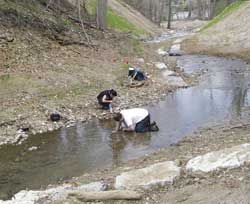Researchers focus attention on threats to Pa. water resources
From abandoned mines to drilling in the Marcellus Shale, urban and suburban sprawl to agriculture and residential runoff, Temple faculty are examining the impact of a range of threats to Pennsylvania’s water resources and seeking ways to mitigate potential problems.
Pennsylvania’s long history as a leading producer of coal has made acid mine drainage in abandoned mines a major problem across the state. Rock left behind after coal is extracted contains sulfur impurities that decompose and form sulfuric acid when exposed to air, water or microbes.
“When water fills a mine’s underground tunnels, it leaches the sulfuric acid off the walls and can get into the nearby groundwater,” said Temple Chemistry Professor Daniel Strongin, who is developing a technology to combat this problem.
Chemicals such as lime are used to neutralize acidic runoff, but they do not eliminate the root cause, Strongin said. So his lab is developing a technology that uses lipid molecules that bind to the metal sulfide, forming a hydrophobic layer that keeps water, oxygen and bacteria from causing it to decompose.
Temple is also playing a major role in informing the debate on one of the biggest economic and environmental issues confronting Pennsylvania. Through the Center for Natural Resources Development and Protection (NRDP), the university has become a primary facilitator of discussion and research on the removal of natural gas from the Marcellus Shale formation through hydro-fracking. NRDP researchers are investigating the potential for leakage of contaminants during the process and assessing the potential impact on the environment.
“If you have leakage from the well casing, say a half-mile below the surface, we want to know how far will that leakage disperse from the well site — will it go a half-mile sideways and into nearby groundwater, lakes and streams or will it come straight up around the well site,” said Michel Boufadel, director of NRDP and chair of Civil and Environmental Engineering. “Fifty years down the road, someone is going to ask if we did a risk assessment on this drilling and it would behoove us to be able to say, ‘Yes, we did.’”
On another environmental issue, Earth and Environmental Science Professor Laura Toran is investigating stream erosion rates caused by increases in stormwater runoff as a consequence of urban and suburban sprawl. Land development throughout the state has created more impervious surfaces, causing increased runoff into creeks and streams. Toran’s work examines the resulting erosion, as well as the efficiency of stormwater control systems.
“There are a number of reasons why stream erosion is bad,” she said. “Obviously, the banks eventually begin to fall apart, which brings down trees along the stream. Plus the sediment starts to build up, choking the stream and smothering the macro-invertebrates that are living there. When they die, the fish that feed off them die.”
Toran said that Pennsylvania requires that new structures have stormwater controls in place; however, there is currently no monitoring system to ensure that they work.
“We can see these streams are being damaged because of the stormwater runoff; we can measure the damage and the rates of damage, and that’s important,” she said. “But we also want to be working on solutions and improving our solutions to these problems by investigating what is working and what is not working.”
Elsewhere, Temple researchers are studying another type of runoff in Pennsylvania’s waterways. Sponsored by Pennsylvania’s Department of Environmental Protection, NRDP researchers Boufadel and Benoit Van Aken are studying the impact on the Delaware estuary of nutrients found in fertilizers used in farming and lawn care.
“If you have a lot of nutrients in the water it can cause an algae bloom, which can block photosynthesis at shallow depths,” said Boufadel. “But more importantly, when the algae die and begin to decay, they deplete the oxygen in the water, which can kill fish.”
Boufadel said they are examining the ecosystem resilience to these nutrient loadings, which keep increasing each year. Through a monitoring site on Tinicum Island, the researchers are evaluating how the river’s banks serve as a natural kidney function that cleans the nutrients out of the river.
